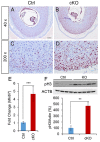Transforming growth factor beta signaling and decidual integrity in mice†
- PMID: 32902612
- PMCID: PMC7711917
- DOI: 10.1093/biolre/ioaa155
Transforming growth factor beta signaling and decidual integrity in mice†
Abstract
Transforming growth factor beta (TGFβ) signaling regulates multifaceted reproductive processes. It has been shown that the type 1 receptor of TGFβ (TGFBR1) is indispensable for female reproductive tract development, implantation, placental development, and fertility. However, the role of TGFβ signaling in decidual development and function remains poorly defined. Our objective is to determine the impact of uterine-specific deletion of Tgfbr1 on decidual integrity, with a focus on the cellular and molecular properties of the decidua during development. Our results show that the developmental dynamics of the decidua is altered in TGFBR1 conditionally depleted uteri from embryonic day (E) 5.5 to E8.5, substantiated by downregulation of genes associated with inflammatory responses and uterine natural killer cell abundance, reduced presence of nondecidualized fibroblasts in the antimesometrial region, and altered decidual cell development. Notably, conditional ablation of TGFBR1 results in the formation of decidua containing more abundant alpha smooth muscle actin (ACTA2)-positive cells at the peripheral region of the antimesometrial side versus controls at E6.5-E8.5. This finding is corroborated by upregulation of a subset of smooth muscle marker genes in Tgfbr1 conditionally deleted decidua at E6.5 and E8.5. Moreover, increased cell proliferation and enhanced decidual ERK1/2 signaling were found in Tgfbr1 conditional knockout mice upon decidual regression. In summary, conditional ablation of TGFBR1 in the uterus profoundly impacts the cellular and molecular properties of the decidua. Our results suggest that TGFBR1 in uterine epithelial and stromal compartments is important for the integrity of the decidua, a transient but crucial structure that supports embryo development.
Keywords: TGFBR1; TGFβ signaling; decidualization; endometrium; uterus.
© The Author(s) 2020. Published by Oxford University Press on behalf of Society for the Study of Reproduction. All rights reserved. For permissions, please e-mail: journals.permissions@oup.com.
Figures







Similar articles
-
Functional similarity between TGF-beta type 2 and type 1 receptors in the female reproductive tract.Sci Rep. 2021 Apr 29;11(1):9294. doi: 10.1038/s41598-021-88673-y. Sci Rep. 2021. PMID: 33927274 Free PMC article.
-
Glandular defects in the mouse uterus with sustained activation of TGF-beta signaling is associated with altered differentiation of endometrial stromal cells and formation of stromal compartment.PLoS One. 2018 Dec 14;13(12):e0209417. doi: 10.1371/journal.pone.0209417. eCollection 2018. PLoS One. 2018. PMID: 30550590 Free PMC article.
-
Transforming growth factor β receptor type 1 is essential for female reproductive tract integrity and function.PLoS Genet. 2011 Oct;7(10):e1002320. doi: 10.1371/journal.pgen.1002320. Epub 2011 Oct 20. PLoS Genet. 2011. PMID: 22028666 Free PMC article.
-
TGFβ superfamily signaling and uterine decidualization.Reprod Biol Endocrinol. 2017 Oct 13;15(1):84. doi: 10.1186/s12958-017-0303-0. Reprod Biol Endocrinol. 2017. PMID: 29029620 Free PMC article. Review.
-
Endometrial TGFβ signaling fosters early pregnancy development by remodeling the fetomaternal interface.Am J Reprod Immunol. 2023 Dec;90(6):e13789. doi: 10.1111/aji.13789. Am J Reprod Immunol. 2023. PMID: 38009061 Free PMC article. Review.
Cited by
-
The endometrial cancer A230V-ALK5 (TGFBR1) mutant attenuates TGF-β signaling and exhibits reduced in vitro sensitivity to ALK5 inhibitors.PLoS One. 2024 Nov 22;19(11):e0312806. doi: 10.1371/journal.pone.0312806. eCollection 2024. PLoS One. 2024. PMID: 39576826 Free PMC article.
-
Transcriptomic Profiling of Gene Expression Associated with Granulosa Cell Tumor Development in a Mouse Model.Cancers (Basel). 2022 Apr 27;14(9):2184. doi: 10.3390/cancers14092184. Cancers (Basel). 2022. PMID: 35565312 Free PMC article.
-
Single-cell analysis of mouse uterus at the invasion phase of embryo implantation.Cell Biosci. 2022 Feb 5;12(1):13. doi: 10.1186/s13578-022-00749-y. Cell Biosci. 2022. PMID: 35123575 Free PMC article.
-
Sertoli Cell-Specific Activation of Transforming Growth Factor Beta Receptor 1 Leads to Testicular Granulosa Cell Tumor Formation.Cells. 2023 Nov 27;12(23):2717. doi: 10.3390/cells12232717. Cells. 2023. PMID: 38067144 Free PMC article.
-
Functional similarity between TGF-beta type 2 and type 1 receptors in the female reproductive tract.Sci Rep. 2021 Apr 29;11(1):9294. doi: 10.1038/s41598-021-88673-y. Sci Rep. 2021. PMID: 33927274 Free PMC article.
References
Publication types
MeSH terms
Substances
Grants and funding
LinkOut - more resources
Full Text Sources
Molecular Biology Databases
Miscellaneous

